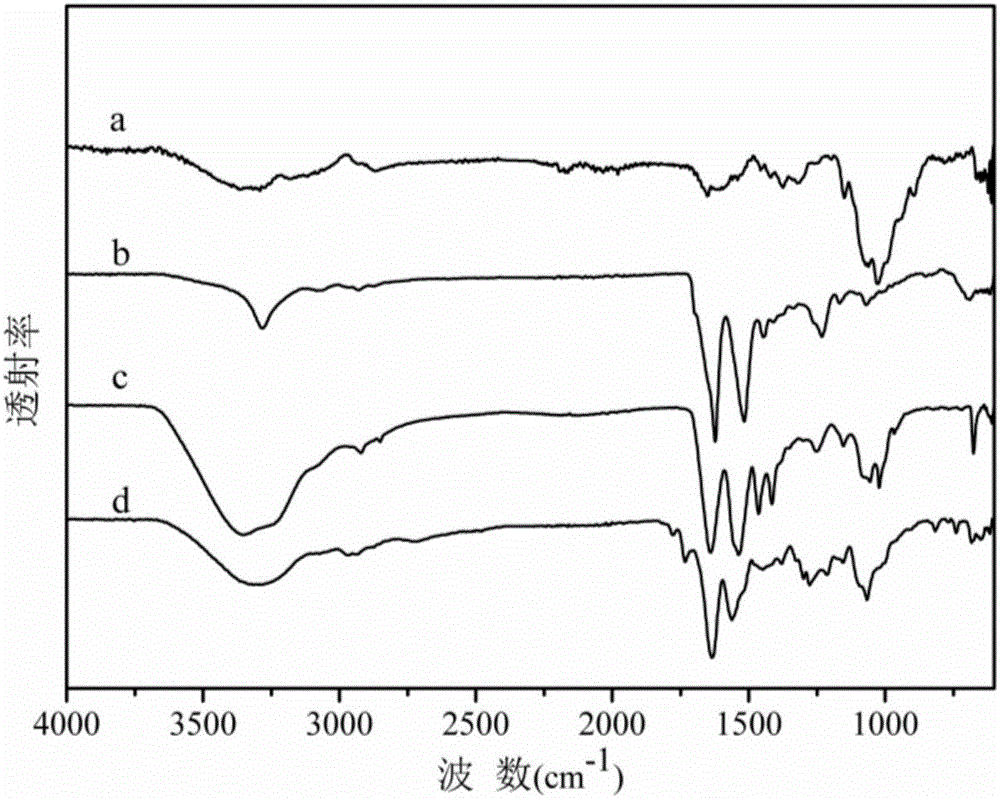Preparation method of composite gel three-dimensional tumor model scaffold
A composite gel, three-dimensional technology, applied in the field of cell biology, can solve the problems of poor pore size uniformity of scaffold materials, unfavorable tumor cell adhesion, complicated preparation process, etc., and achieves shortened preparation time, suitable pore size and uniformity, The effect of simplifying the synthesis step
- Summary
- Abstract
- Description
- Claims
- Application Information
AI Technical Summary
Problems solved by technology
Method used
Image
Examples
Embodiment 1
[0052] 1. Preparation of silk fibroin-chitosan composite gel three-dimensional tumor model scaffold
[0053] Take an appropriate amount of chitosan (molecular weight is 8500Da) and put it into a mortar and grind it finely, and dry it in an oven at 50°C, then weigh 1g of the powder, add it to 100mL of 1% glacial acetic acid aqueous solution, stir to dissolve it, and obtain Chitosan solution with a concentration of 0.01 g / mL. Put the chitosan solution in a refrigerator at 4°C overnight to let the air bubbles out of the solution. Put 10mL of silk fibroin solution with a concentration of 150g / L into a plastic container, slowly add 7mL of chitosan solution with a concentration of 0.01g / mL while stirring, then add 96mg of EDC and 57.5mg of NHS, stir well , 5 mL of n-butanol was added dropwise, and after 5 minutes, the solution was gel-like. Stop stirring, put the gel in a refrigerator at 4°C for 3 minutes to remove air bubbles in the gel, then put it in a refrigerator at -20°C for...
Embodiment 2
[0060] Take an appropriate amount of chitosan and grind it into a mortar, dry it in an oven at 50°C, then weigh 1g of the powder, add it to 100mL of 1% glacial acetic acid aqueous solution, stir to dissolve it, and obtain a concentration of 0.01 g / mL chitosan solution. Put the chitosan solution in a refrigerator at 4°C overnight to let the air bubbles out of the solution. Put 10mL of silk fibroin solution with a concentration of 75g / L into a plastic container, slowly add 7mL of chitosan solution with a concentration of 0.01g / mL while stirring, then add 134.4mg of EDC and 80.5mg of NHS, and stir evenly Finally, 4.25 mL of n-butanol was added dropwise for denaturation. After 5 minutes, the solution was gel-like. Stop stirring, put the gel in the refrigerator at 8°C for 3 minutes to remove the air bubbles in the gel, then put it in the refrigerator at -20°C for 20 minutes, and put it in the refrigerator at -80°C for molding , taken out after 24 hours, and freeze-dried to obtain...
Embodiment 3
[0062] Take an appropriate amount of chitosan and grind it into a mortar, dry it in an oven at 50°C, then weigh 1g of the powder, add it to 100mL of 1% glacial acetic acid aqueous solution, stir to dissolve it, and obtain a concentration of 0.01 g / mL chitosan solution. Put the chitosan solution in a refrigerator at 6°C overnight to let the air bubbles out of the solution. Put 10mL of silk fibroin solution with a concentration of 75g / L into a plastic container, slowly add 3mL of chitosan solution with a concentration of 0.01g / mL while stirring, then add 57.6mg of EDC and 34.5mg of NHS, and stir evenly After that, 3.25 mL of n-butanol was added dropwise, and after 5 minutes, the solution was gel-like. Stop stirring, put the gel in a refrigerator at 4°C for 3 minutes to remove air bubbles in the gel, then put it in a refrigerator at -20°C for 20 minutes, and put it in a refrigerator at -80°C for molding , taken out after 24 hours, and freeze-dried to obtain a silk fibroin-chito...
PUM
| Property | Measurement | Unit |
|---|---|---|
| Concentration | aaaaa | aaaaa |
| Molecular weight | aaaaa | aaaaa |
Abstract
Description
Claims
Application Information
 Login to View More
Login to View More - R&D
- Intellectual Property
- Life Sciences
- Materials
- Tech Scout
- Unparalleled Data Quality
- Higher Quality Content
- 60% Fewer Hallucinations
Browse by: Latest US Patents, China's latest patents, Technical Efficacy Thesaurus, Application Domain, Technology Topic, Popular Technical Reports.
© 2025 PatSnap. All rights reserved.Legal|Privacy policy|Modern Slavery Act Transparency Statement|Sitemap|About US| Contact US: help@patsnap.com



